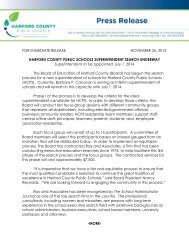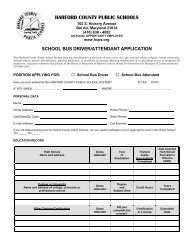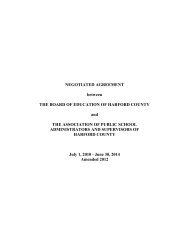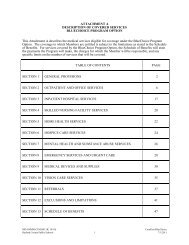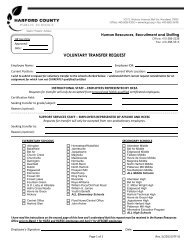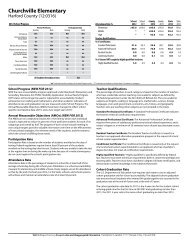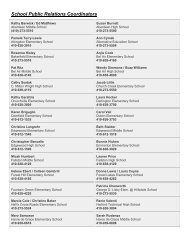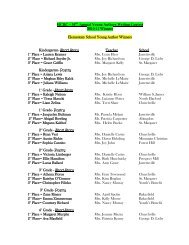Parent Handbook - Harford County Public Schools
Parent Handbook - Harford County Public Schools
Parent Handbook - Harford County Public Schools
You also want an ePaper? Increase the reach of your titles
YUMPU automatically turns print PDFs into web optimized ePapers that Google loves.
inspections. Through a system of inspection, documentation, communication with building<br />
occupants and evaluation of any required actions, an effective program of pest control is<br />
currently in place.<br />
Priority is given to non-chemical pest management techniques. However, there will be<br />
occasions when pesticide application is necessary. Application will be done in a manner<br />
sufficient to minimize potential exposure to occupants and building environment. In compliance<br />
with regulations as set forth by Maryland Department of Agriculture, notification will be made<br />
to the parent(s)/guardian(s) of all elementary students and staff, and parent(s)/guardian(s)<br />
of secondary student(s) attending a secondary school, or <strong>Harford</strong> <strong>County</strong> <strong>Public</strong> <strong>Schools</strong><br />
staff and wish to be notified of all pesticide applications on school properties, contact school<br />
administration to request written notification.<br />
Information about pesticides or bait stations that may be used in school buildings or on school<br />
grounds when non-chemical techniques are exhausted or inappropriate can be obtained<br />
through the Facilities Management Department, 2209 Conowingo Rd, Bel Air, MD 21015.<br />
The Executive Director of Facilities serves as coordinator and maintains product labels and<br />
material safety data sheets (MSDS) for each product. Currently, these pesticides and bait<br />
stations include (by common name) Amorphous Silica Gel, Borate, Borax, Bromadiolone,<br />
Bromethalon, Carbon, Chlorfenapyr, Cyfluthrin, Cypermethrim, D-Trans Allethrin, Deltamethrin,<br />
Diphacinone, Dimethylamine salt of 2,4 and Fiprobnil, Glyphosate, Hydramethylon,<br />
Hydroprene, Imidacloprid, Methoprene, s-metochlor, Napthalene, Orthoboric Acid, Oxadizon,<br />
Permethrin, Potassium Salt of Fatty Acid, Pyrethrins, Resmethrin, Sodium Nitrate, and Sulfer.<br />
The public can review this information by contacting the program coordinator at 410-638-<br />
4088. Copies can be obtained for the cost of reproduction. A more detailed description of IPM<br />
techniques employed by <strong>Harford</strong> <strong>County</strong> <strong>Public</strong> <strong>Schools</strong> may be found in the IPM manual<br />
located at each school site.<br />
For further information regarding <strong>Harford</strong> <strong>County</strong> <strong>Public</strong> <strong>Schools</strong> Integrated Pest Management<br />
Program contact the Executive Director of Facilities Management at 410-638-4088.<br />
Notification Of AHERA Inspection & Management Plan Compliance<br />
This notification is to inform interested parties such as teachers, school personnel, and parents<br />
about Asbestos Hazard Emergency Response Act (AHERA) requirements and the actions<br />
taken by <strong>Harford</strong> <strong>County</strong> <strong>Public</strong> <strong>Schools</strong> to comply with AHERA regulations. On October<br />
30, 1987, the AHERA regulations were published in the Federal Register, pages 41826 to<br />
41898, titled “Asbestos Containing Materials in <strong>Schools</strong>.” These regulations require a Building<br />
Inspection to find asbestos containing material (ACM) within each school building and a<br />
Management Plan for each building. Building Inspections have been conducted by an EPA<br />
accredited Building Inspector. Management Plans have been written by an EPA accredited<br />
Management Planner for each school, cataloging ACM found by the Building Inspection.<br />
Building Inspections and Management Plans have been completed for all <strong>Harford</strong> <strong>County</strong><br />
<strong>Public</strong> <strong>Schools</strong>. These documents have been submitted to the State of Maryland in compliance<br />
with AHERA’s May 9, 1989, deadline. The individual building reports include schedules for<br />
periodic surveillance of ACM, re-inspection to be conducted by an accredited EPA Building<br />
Inspector, and response actions planned, as well as those already completed. The first<br />
re-inspection of <strong>Harford</strong> <strong>County</strong> <strong>Public</strong> <strong>Schools</strong>’ buildings was completed in 1992; and<br />
subsequent re-inspections were performed in 1995, 1998, 2001, 2004, 2007 and 2010.<br />
Management Plans are available for public review at school administrative offices. To minimize confusion,<br />
and in order for a representative of the school system to be available, all who wish to review the reports are<br />
requested to make an appointment with school administrators. <strong>Public</strong> viewing is at no cost to the individual.<br />
Copies of the various reports are available for a fee based upon the copying costs of the individual report<br />
requested.<br />
Most <strong>Harford</strong> <strong>County</strong> schools do have asbestos containing materials (ACM), and all schools that do, have it<br />
identified and catalogued in their management plans. Those materials are monitored by school and facilities<br />
staff, and reinspected every three years by certified inspectors. In the event that deterioration is noted, or<br />
maintenance action in the area of the materials requires that the ACM be removed, it is removed only by<br />
certified contractors, with monitoring by a separate industrial hygiene contractor. No one other than certified<br />
contractors; not school staff, not teachers, not students, nor parents should EVER take it upon themselves to<br />
attempt to remove known or suspected asbestos containing materials for any reason.<br />
Notification Of Planning For Incidents At The Peach Bottom Power Station<br />
In the event of an incident at the Peach Bottom Atomic Power Station (PBAPS), plans have been made to<br />
increase the safety of public school students at schools within 10 miles of Peach Bottom. The following home<br />
schools are within the 10 mile radius and could possibly be evacuated to a host school. The host schools are:<br />
<strong>Schools</strong> within TenMiles of Peach Bottom<br />
Darlington Elementary<br />
Dublin Elementary<br />
North <strong>Harford</strong> Elementary<br />
North <strong>Harford</strong> Middle<br />
North <strong>Harford</strong> High<br />
Host <strong>Schools</strong><br />
Meadowvale Elementary<br />
Churchville Elementary<br />
North Bend Elementary<br />
Hickory Elementary<br />
C. Milton Wright High<br />
In the event of an incident at the Peach Bottom Atomic Power Station which requires the evacuation of<br />
a school, students will be transported by bus directly to the HOST school. If such evacuation is ordered,<br />
notification will be publicized by radio and television stations, and through the automated telephone system.<br />
<strong>Parent</strong>s or authorized persons are to meet their children at the assigned school. <strong>Parent</strong>s are urged not to<br />
telephone schools or attempt to make different arrangements. This will only create confusion. <strong>Parent</strong>s are<br />
requested not to pick up their children at the HOME school, but to meet their children at the HOST school.<br />
<strong>Parent</strong>s or other persons authorized to pick up a student will be required to provide identification at the pick-up<br />
point and sign a register prior to the release of a student to their custody.<br />
Notification Of Sampling For Lead In Drinking Water<br />
Medical research shows lead to be a toxic metal which can be harmful to human health even at low exposure<br />
levels. As evident by research, young children, infants, and fetuses are particularly vulnerable to lead exposure,<br />
at lower exposure limits than adults. The effects are observed in physiological and behavioral symptoms.<br />
The degree of harm from lead depends upon the total exposure to lead from all sources, and is cumulative over<br />
your lifespan. Children as well as adults continue to be exposed to lead from a number of sources, including<br />
dust from lead paint and soil, food, and water. For more information on these sources, please contact the<br />
<strong>County</strong> Health Department at 410-838-1500, or the Maryland Department of the Environment at 410-537-3000.<br />
In October 1988, Congress passed the Lead Contamination Control Act in order to prevent lead contamination<br />
of drinking water in schools and daycare centers. The Act required the Environmental Protection Agency (EPA)<br />
to publish a list of water coolers that were known to contain lead. It also required schools and daycare centers<br />
to take actions to reduce lead from other sources of drinking water to no more than 20 parts per billion.<br />
14



